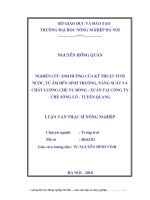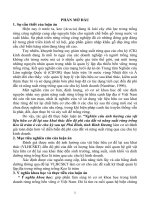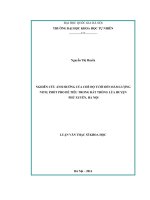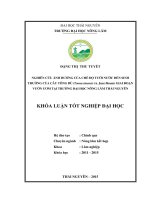Nghiên cứu ảnh hưởng của việc thay thế một phần và hoàn toàn cát tự nhiên bằng đá mi bụi đến các tính chất của bê tông tươi và bê tông sau khi đã đóng rắn
Bạn đang xem bản rút gọn của tài liệu. Xem và tải ngay bản đầy đủ của tài liệu tại đây (741.26 KB, 7 trang )
BÀI BÁO KHOA HỌC
INFLUENCE OF PARTIAL AND FULL REPLACEMENT OF NATURAL
SAND WITH QUARRY STONE DUST ON PROPERTIES OF FRESH AND
HARDENED CONCRETE
Nguyễn Việt Đức1
Abstract: The shortage of natural sand for concrete production in Vietnam,especially in the
Southern area, requires to find an alternative to relieve this issue. In this paper, quarry stone dust
was used as an alternative to natural sand for concrete mix proportion. Moreover, the effect of
partial to full replacement of natural river sand with this type of aggregate on the workability,
compressive strength and flexural strength of concrete was studied. The results showed that
although the use of quarry stone dust caused a reduction in slump value, compressive and flexural
strength were comparable to the case of using natural sand.However, in case the superplasticizer
was used for concrete mix with 80%-100% quarry stone dust replacement, both of fresh and
hardened state properties of concrete were improved significantly.
Keywords: Quarry stone dust, natural sand, concrete mix proportion, workability, compressive
strength, flexural strength.
1. INTRODUCTION*
Rapid growth in the infrastructure has made
concrete the most widely and commonly used
construction material throughout the world as
well as in Vietnam. This has created immense
pressure on the concrete industry to produce a
large quantum of concrete to meet the growing
demand for infrastructure development. The
cost of concrete production primarily depends
on the cost of its constituent raw materials,
cement, aggregates (coarse and fine) and water
(Aitcin, 1998). Among the constituent raw
materials, fine aggregate or mostly natural sand
which forms around 35% of the concrete
volume plays an important role in deciding the
cost of concrete (Neville, 2002; Nguyen &
Dang, 2016). In Vietnam, currently there are
merely few sand quarries and they are
distributed unevenly from the North to the
South. Hence, in many regions of the country
sand has to be transported from far away for
concrete production. In addition, depleting
1
Bộ môn Vật liệu Xây dựng, Khoa Công trình, Trường
Đại học Thủy lợi.
128
sources of natural river sand and strict
environmental guidelines on mining from the
government has gradually shifted the attention
of the concrete industry towards a suitable fine
aggregate alternative that can replace the
presently used natural sand (Mundra et al.,
2016; Nguyen, 2017).
One of the substantial solutions for reducing
the sand excavation from natural resources as
well as diminishing the cost of concrete is to use
quarry stone dust with an equivalent grading to
natural sand (Sukesh et al., 2013; Le & Nguyen,
2017). This type of sand, which has a grading of
0-5mm, is a by-product in the seiveing process
of coarse aggregate manufacture at the stone
quarry. Up to the present, this sand has been
used mostly to make floor tiles, brick, and
additives for precast pipes and road building as
well as for other construction materials.
According to a detailed statistic for Ho Chi
Minh City area and nearby, which is
geographically adjacent to some stone quarries
in Bien Hoa - Dong Nai and Di An - Binh
Duong, the use of quarry stone dust as fine
aggregate might reduce the cost of raw material
KHOA HỌC KỸ THUẬT THỦY LỢI VÀ MÔI TRƯỜNG - SỐ 63 (12/2018)
for concrete production up to 50% in
comparison with the case of natural river sand
owing on mainly transportation cost (Pham,
2014).
So far, several studies have been conducted
to study the effect of natural sand replacement
with quarry stone dust (Sukesh, 2013; Pham,
2014; Mundra, 2016; Le & Nguyen, 2017).
Although the partial replacement up to 50%
natural sand resulted in decreasing slump value,
concrete made using quarry stone dust attained
the comparable compressive strength as the
control concrete. However, a significant
reduction in the cost of concrete without
affecting the strength property was also reported
(Nguyen, 2017). In order to explore more
thoroughly on the theme, the present paper
dedicates to examine in detail how the partial to
full replacement of natural river sand with
quarry stone dust effects on the workability,
compressive strength and flexural strength of
concrete, which has not been studied yet.
2. MATERIALS
USED
AND
EXPERIMENTAL PROGRAM
The material used for this study are presented
as follows:
2.1. Cement
Cement used in this study is ordinary Portland
Blended cement PCB40 with commercial band
Ha Tien, which is conforming to the standard
TCVN 2682:2009. Physical and mechanical
characteristics of cement are given in Table 1.
Table 1. Physical and mechanical characteristics of cement
Parameters
Specific density
Bulk density
Blaine fineness
Consistency
Initial setting time
Final setting time
Soundness of cement
3 days compressive strength
28 days compressive strength
Units
g/cm3
g/cm3
cm2/g
%
min.
min.
mm
N/mm2
N/mm2
2.2. Fine and coarse aggregates
Natural sand from Dong Nai River was used as
fine aggregate for concrete mix. In addition,
both of crushed stone and quarry stone dust
were brought from the stone quarry Di An-Binh
Test results
3.11
1.3
3350
28.2
105
295
2.1
33.0
48.5
Duong. Characteristic of fine and coarse
aggregates is provided in Table 2. Besides, in
order to obtain grading of aggregates, sieve
analysis was also carried, the results are shown
in Table 3.
Table 2. Characteristic of coarse and fine aggregates
Parameters
Specific density
Bulk density
Water absorption
Clay, silt and
content
Fineness modulus
dust
Units
g/cm3
g/cm3
%
Crushed stone
2.71
1.48
0.9
Sand
2.64
1.55
1.5
Stone dust
2.7
1.65
1.9
%
1.5
0,96
1.5
-
-
2.34
3.01
KHOA HỌC KỸ THUẬT THỦY LỢI VÀ MÔI TRƯỜNG - SỐ 63 (12/2018)
129
Table 3. Gradation of aggregates by sieve analysis
Sieve size
Crushed stone
70
0.0
40
2.9
20
49.5
10
80.3
5
98.0
Stone dust
Cumulative % retained
Sand
0.0
0.0
2.5
19.5
9.5
1.25
37.8
21.8
0.63
61.6
36.6
0.315
84.2
71.2
0.14
98.4
95.4
100
100
Pan
100
2.3. Chemical admixture and water
Chemical admixture used is a high-range water
reducer admixture with commercial name
SikaPlast®-151V,
which
is
a
third
generationpolycarboxylate superplasticizer that
was provided from Sika-Vietnam factory at
Nhon Trach-Dong Nai. Water used in this study
is tap water at Ho Chi Minh City area.
Characteristic of water and admixture is shown
in Table 4.
Table 4. Characteristic of water and admixture
Parameter
Specific density
pH value
Units
g/cm3
-
Admixture
1,075 ÷1,095
4÷6
2.4. Experimental program
In this study, concrete design mixes
corresponding to strength class of 30MPa at the
age of 28 days were prepared. This strength
class was chosen on the basis of the discussion
with the research partner (Bao Viet Consulting
Company) and this concrete grade is currently
considered as the most commonly-used at Ho
Chi Minh City area and nearby.
In total, eight concrete mixes were prepared;
among them in terms of fine aggregate the first
one (M1) was concrete with 100% natural river
sand, the following ones nominated as M2, M3,
M4, M5, and M6 are mixes that 20%, 40%,
60%, 80%, and 100% respectively natural sand
were replaced by quarry stone dust. The last
130
Water
1
7
mixes M7 and M8 are similar to mixes M5 and
M6, except the addition of chemical admixture.
The admixture content is considered in
accordance with the supplier recommendation.
All of the aforementioned concrete mixes are
included in Table 5 below.
Concrete preparation was done by means of
pan-mixer with the following procedure: firstly
fine and coarse aggregates plus half of water
content were mixed for two minutes and then
cement was added and mixed for one minute,
finally the rest of water was added and mixed
for one more minute before concrete is
discharged for test at fresh state. If the chemical
admixture or superplasticizer is used, it will be
added at the final step. Concrete slump test was
KHOA HỌC KỸ THUẬT THỦY LỢI VÀ MÔI TRƯỜNG - SỐ 63 (12/2018)
carried out right after mixing.
In order to obtain compressive strength and
flexural strength of the concrete mixes at
different ages (3, 7 and 28 days), after slump
test of each concrete mix 9 cubic
(150x150x150mm3)
and
9
prism
(100x100x400mm3) specimens were prepared.
After casting into the mould, the specimens
were kept in the laboratory for 24 hours, then
they were removed from the moulds and cured
under standard condition (T=20±2oC; W>95%)
up to the testing date.
Table 5. Mix proportion of concrete strength class 30MPa
Natural
sand
kg
310
310
310
310
310
310
310
310
kg
750
600
450
300
150
150
-
Mix
M1
M2
M3
M4
M5
M6
M7
M8
Quarry stone dust
(replacement
percentage)
kg
150 (20%)
300 (40%)
450 (60%)
600 (80%)
750 (100%)
600 (80%)
750 (100%)
3. RESULTS AND DISCUSSION
3.1. Fresh state properties
The workability of concrete is defined in terms
of the slump value. This value is exhibited in
mm and presented in Figure 1. The results
indicate that the more natural sand is replaced
by quarry stone dust, the less slump value. It
might be due to the fact that surface roughness
of the stone dust is much greater than that of
natural river sand, which consists of mostly
round particles with smooth surface. Hence,
concrete made with the stone dust has become
less workable. Besides, the mixes using stone
dust (M2-M6) need more vibration or energy to
compact into the mould in comparison with the
mix M1 using natural sand.
The addition of superplasticizer only about
0.6% of cement content to mixes M7-M8 has
made concrete mix much more workable in
comparison with the corresponding mixes M5M6, as the slump values can be seen in Figure 1,
eventhough 100% natural river sand was
replaced by quarry stone dust in M8. This
means that in case of using stone dust for
concrete production it is suggested to employ
Crushed
stone
Admixture (relation
to cement content)
Water
kg
1070
1070
1070
1070
1070
1070
1070
1070
L
1,8 (0.6%)
1.8 (0.6%)
L
195
195
195
195
195
195
195
195
superplasticizer in order to make concrete
workable at the fresh state.
KHOA HỌC KỸ THUẬT THỦY LỢI VÀ MÔI TRƯỜNG - SỐ 63 (12/2018)
90
80
70
Slump value,mm
Cement
60
50
40
30
20
10
0
0
20
40
60
80 100
Replacement percentage, %
Without admixture (M1-M6)
With admixture (M7-M8)
Figure 1. Slump value versus sand
replacement percentage
131
The fresh state performance of concrete
mixes M5 and M7 without and with chemical
admixture are shown in Figure 2 and Figure 3
respectively. Evidently, during the experiment,
Figure 2. Fresh state performance of M5
(without chemical admixture)
3.2. Hardened state properties
Compressive and flexural strength of
concrete mixes are checked at the age of 3, 7,
and 28 days. It is well-known that concrete
strength class is determined in accordance with
the 28-day compressive strength of concrete,
nevertheless an awareness of concrete strength
at the early age clarifies the strength evolution
of concrete, which is useful data for contractor
from practical point of view, because it might
accelerate the construction process thought the
quality of construction is still maintained
(Aitcin, 1998; Neville, 2002; Le & Nguyen,
2017). Flexural strength is defined by thirdpoint bending test on 100x100x400mm3
specimens. Compressive and flexural strength
of concrete evolution are shown in Figure 4 and
Figure 5 respectively. In these figures, for every
concrete mixes (M1-M8) at the age of 3, 7 and
132
it recognizes that the mix M5 requires vibration
by hand poker much more than the mix M7 does
in order to compact the mixes into the moulds.
Figure 3. Fresh state performance of M7
(with chemical admixture)
28 days each of the plotted data is an average of
three test values.
Looking into the Figure 4, it can be seen that
all of the concrete mixes attain strength class of
30MPa at the age of 28 days, except mixes M5M6 with the replacement percentage of 80% and
100% respectively. The replacement of 20% and
40% natural sand by stone dust results in a
comparable compressive strength, while the
replacement of 60% sand causes reduction
about 10% in strength. This result is similar to
that of Sukesh et al. (2013) obtained before.
However, the use of superplasticizer makes the
concrete mixes M7 and M8 resulting in higher
compressive strength than the others at the age
of 3, 7 and 28 days, eventhough the replacement
percentage is 80% and 100% respectively. This
indicates that the superplasticizer improves
compressive strength at the early age
KHOA HỌC KỸ THUẬT THỦY LỢI VÀ MÔI TRƯỜNG - SỐ 63 (12/2018)
significantly. In general, it is observed that
compressive strength of concrete at the age of 3
and 7 days is about 60% and 85% respectively
the corresponding ones at the age of 28 days.
Figure 4. Compressive strength of concrete
versus quarry stone dust replacement
percentage at different ages (filling maker
illustrates mixes with admixture)
Figure 5.Flexural strength of concrete versus
quarry stone dust replacement percentage at
different ages (filling maker illustrates mixes
with admixture)
Regarding flexural strength, similar behavior
is also observed. Although in concrete mix M8
100% natural river sand is replaced by quarry
stone dust, flexural strength is about 3-15%
higher in comparison with mix M1. This also
points out thatthe use of superplasticizer for
concrete mix with 100% quarry stone dust
enhance flexural strength particularly at the
early age (3 and 7 days).
4. CONCLUSION
The concrete of strength class 30MPa at
the age of 28 days with partial to full
replacement of natural river sand by quarry
stone dust was studied in this paper. The
results indicated that in terms of fresh state
properties the use of stone dust caused a
remarkable reduction in slump value or
concrete mix at fresh state becomes less
workable. This requires more vibration or
energy to compact the mix into the mould.
Hence, it is suggested to employ the
superplasticizer when using the dust for
concrete production, especially for the case
of full replacement. Regarding the hardened
state of concrete mixes, compressive and
flexural strength of mixes using quarry stone
dust were comparable to that of the mixes
using natural river sand at the age of 3, 7 and
28 days up to replacement of 40%. Beyond
this value, the reduction in strength was
observed. Furthermore, among eight concrete
mixes studied the addition of superplasticizer
resulted in the concrete mix with the highest
strength, eventhough it was involved with
100% replacement of quarry stone dust.
REFERENCES
Le, T. & Nguyen V. Đ. (2017). Một số lưu ý trong việc sử dụng đá mi bụi làm cốt liệu nhỏ cho thiết
kế cấp phối bê tông. Tạp chí Khoa Học và Công Nghệ Trường Đại Học Công Nghiệp TP.HCM,
số 25, trang 104-111.
Nguyen, V. Đ. (2017). Thiết kế cấp phối bê tông sử dụng đá mi bụi. Kỷ yếu Hội nghị Khoa Học
Thủy Lợi toàn quốc ISBN: 978-604-82-2273-4. Trang 4-6.
Pham, T. H. (2014). Thực nghiệm sử dụng đá nghiền làm cốt liệu mịn trong sản xuất bê tông tại
công ty VLXD 1828. Luận Văn Tốt Nghiệp, Bộ môn vật liệu silicate, Khoa công nghệ vật liệu,
Trường ĐHBK TPHCM.
KHOA HỌC KỸ THUẬT THỦY LỢI VÀ MÔI TRƯỜNG - SỐ 63 (12/2018)
133
Aitcin P.C. (1998). High Performance Concrete. E&FN SPON, London.
Mundra, S., Sindhi, P. R., Chandwani, V., Nagar, R., Agrawal, V. (2016). Crushed rock sand - An
economical and ecological alternative to natural sand to optimize concrete mix. Perspectives in
Science Vol. 8, p. 345-47.
Neville A.M. (2002). Concrete Properties 4th edition. Person Education Limited, Edinburgh.
Nguyen, V. Đ & Dang, H. M. (2016). High performance concrete mixture proportioning multiobjective optimization approach. Scientific journal of Ho Chi Minh City Open University No.
20(4), p. 65-76.
Sukesh, C., Krishna, K. B., Teja, P.S.L.S., Rao, S.K. (2013). Partial replacement of sand with
quarry dust in concrete. International Journal of Innovative Technology and Exploring
Engineering Vol. 2(6), p. 254-58.
Tóm tắt:
NGHIÊN CỨU ẢNH HƯỞNG CỦA VIỆC THAY THẾ MỘT PHẦN VÀ
HOÀN TOÀN CÁT TỰ NHIÊN BẰNG ĐÁ MI BỤI ĐẾN CÁC TÍNH CHẤT
CỦA BÊ TÔNG TƯƠI VÀ BÊ TÔNG SAU KHI ĐÃ ĐÓNG RẮN
Cát tự nhiên dành cho sản xuất bê tông đang ngày càng cạn kiệt ở Việt Nam đặc biệt ở khu vực
phía Nam đòi hỏi cần phải nghiên cứu vật liệu thay thế để giải quyết vấn đề này. Trong bài báo này
đá mi bụi được sử dụng như vật liệu thay thế cho cát tự nhiên trong các thiết kế cấp phối bê tông.
Ngoài ra, ảnh hưởng của việc thay thế một phần và hoàn toàn cát tự nhiên bằng loại cốt liệu này
lên tính công tác, khả năng kháng uốn và nén của bê tông đã được nghiên cứu. Kết quả chỉ ra rằng
mặc dù việc sử dụng đá mi bụi làm giảm độ sụt của hỗn hợp bê tông tươi, tuy nhiên khả năng kháng
uốn và nén của bê tông khi đã đóng rắn là tương đương với trường hợp bê tông sử dụng cát tự
nhiên. Tuy vậy, khi sử dụng phụ gia hóa dẻo cho bê tông có sử dụng 80%-100% đá mi bụi, chất
lượng của bê tông tươi và bê tông đã đông cứng được cải thiện rõ rệt.
Từ khóa: Đá mi bụi, cát tự nhiên, cấp phối bê tông, tính công tác, khả năng kháng nén, khả năng
kháng uốn.
Ngày nhận bài:
17/12/2018
Ngày chấp nhận đăng: 05/01/2019
134
KHOA HỌC KỸ THUẬT THỦY LỢI VÀ MÔI TRƯỜNG - SỐ 63 (12/2018)









